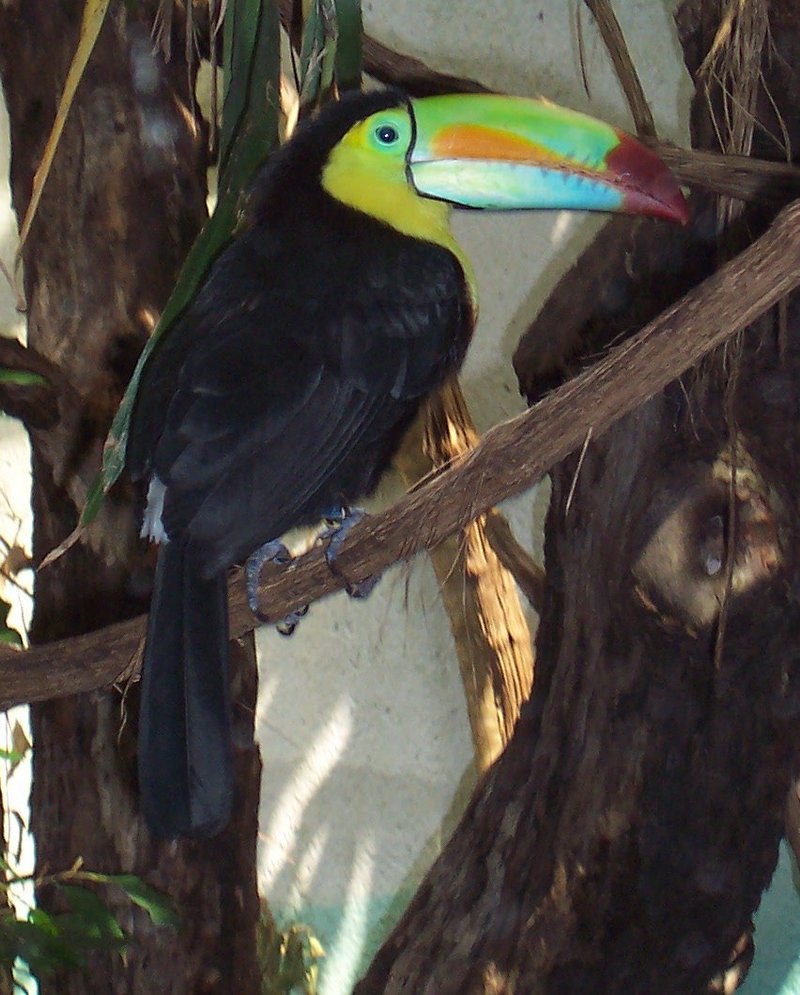Keel-billed Toucan
From Wikipedia, the free encyclopedia
Order: Piciformes
Family: Ramphastidae
[Photo] Keel-billed Toucan (Ramphastos sulfuratus) photographed in Z??rich Zoo. Date 2007-05-18. Author Nevena Tarlanovi??. Copyright (C) 2007 Nevena Tarlanovi??
Permission is granted to copy, distribute and/or modify this document under the terms of the GNU Free Documentation License, Version 1.2 or any later version published by the Free Software Foundation; with no Invariant Sections, no Front-Cover Texts, and no Back-Cover Texts. A copy of the license is included in the section entitled "GNU Free Documentation License". |
The Keel-billed Toucan (Ramphastos sulfuratus), also known as Sulfur-breasted Toucan, Rainbow-billed Toucan, and colloquially "the bill bird" (though this might refer to any toucan and even the completely unrelated hornbills), is a colorful South American bird with a large bill. It is the national bird of Belize.
Description
Including their bills, Keel-billed Toucans range in length from around 17 to 22 inches (42-55 cm). Their large and colorful bills averages around 5-6 in (12-15 cm), but can be up to one third of its length. While the bill seems large and cumbersome, it is in fact a spongy, hollow bone covered in keratin, a very light and hard protein.
The plumage of the Keel-billed Toucan is mainly black with a yellow neck and chest. Molting occurs once per year. They have blue feet and red feathers at the end of their tails. Their bills are mainly green with a red tip and orange sides.
Distribution and ecology
Keel-billed Toucans can be found from Southern Mexico to around Venezuela and Colombia. They roost in the canopies of tropical, subtropical, and lowland rainforests, but may on occasion ascend to altitudes of 1,900 m. They make their homes in holes in trees, often living with several other toucans. This can be a very cramped living space, so they tuck their tails and beaks under themselves to conserve space while sleeping. Adding to the lack of space, the bottoms of the holes are often covered with pits from the fruit the toucans have eaten.
Like many toucans, Keel-billed Toucans are very social, very playful birds. They travel in small flocks approximately six to twelve individuals through lowland rainforests, but as it is a poor flyer, they move mostly by hopping around trees. They have a family structure within their group. They will often be seen "dueling" with each other using their bills, and throwing fruit into each other's mouths. As mentioned before, Keel-billed Toucans live together in these groups, often sharing cramped living quarters of holes in trees. They are rarely seen alone. Able to utiliuze human-altered habitat to some extent, this widespread bird is considered to be a Species of Least Concern by the IUCN.
Diet
The diet of Keel-billed Toucans consists mostly of a wide range of fruit, but may also include bird eggs, insects, lizards, tree frogs. Their bill, surprisingly dexterous, allows them to utilize a large variety of fruit that might not otherwise be reached. When eating the fruit, Keel-billed Toucans will use their bill to pick the fruit, and then toss their heads back and swallow the fruit whole.
Breeding
The female Keel-billed Toucan will usually lay a clutch of two to four (rarely just one) white eggs. The male and female share in the caring of the eggs, both taking turns sitting on them. The eggs hatch approximately 15-20 days after being laid. After hatching, the male and female again take turns feeding the chicks. When the chicks hatch, they have no feathers, and keep their eyes closed for approximately three weeks. The chicks have adequately formed heel pads, which assist them in their life in the bottom of the nest, which gets covered with the pits of their food. The chicks will stay in their nest for approximately eight to nine weeks as their bills develop fully and they become ready to fly.
Aviculture
Keel-billed Toucans require spacious cages to hop back and forth in because of their active nature, and require toys in their cage to prevent boredom. Their high fruit diet and sensitivity to hemochromatosis (an iron storage disease) make them difficult for the novice keeper to maintain. They also like to play with their food, flinging it around, and have soft feces due to their fruit-based diet, and thus can become quite messy.
http://en.wikipedia.org/wiki/Keel-billed_Toucan
| The text in this page is based on the copyrighted Wikipedia article shown in above URL. It is used under the GNU Free Documentation License. You may redistribute it, verbatim or modified, providing that you comply with the terms of the GFDL. |
|

